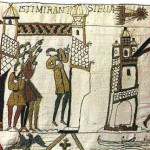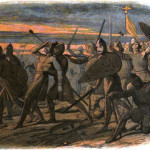Embroidered, Not Woven
One of the most amazing pieces of medieval artwork is the Bayeux Tapestry (actually, it’s an embroidery). It is a hand-stitched (tapestries are woven) account of the Battle of Hastings and the events leading up to the battle.
Most accounts date the origin of the Bayeux Tapestry to either right after or several decades after the battle. The fact that something as fragile and vulnerable as this tapestry has survived almost a thousand years is quite incredible.

Halley’s Comet-Honorable Mention
The tapestry is approximately 224 feet long made up of sections beginning with the meeting of King Edward the Confessor and Earl Harold Godwin. Only 15 individuals are actually mentioned in the tapestry. Only five women are depicted. Including the women, there are a total of 626 humans stitched onto the tapestry, not to mention the horses, buildings, ships, and other interesting items (including Halley’s Comet).
Most people look at the tapestry as a tribute to the Norman victory on 14 October 1066 (i.e., from the French perspective). However, Andrew Bridgeford, in his fascinating book, 1066: The Hidden History in the Bayeux Tapestry, makes a strong case that the tapestry was the work of the English and the tapestry tells a much different story than originally thought. Read More The Bayeux Tapestry: Norman or Anglo-Saxon?

